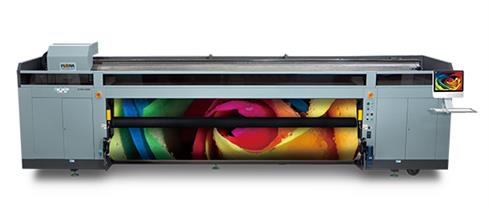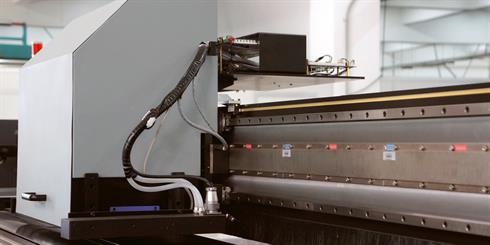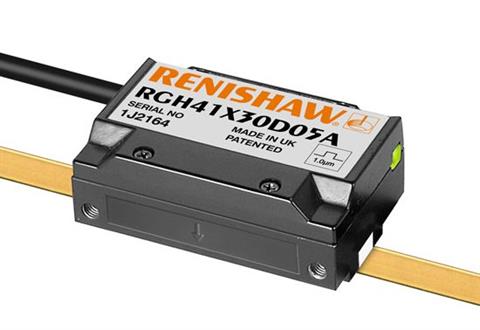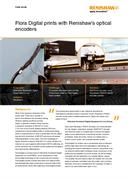Cette page n'est pas disponible actuellement dans votre langue. Vous pouvez en afficher une traduction automatique avec l'outil Google Translate. Cependant nous déclinons toute responsabilité quant à ce service et nous ne contrôlons pas les résultats de la traduction.
Pour en savoir plus à ce sujet, contactez-nous.
Flora Digital prints with Renishaw's optical encoders
Background
What is the maximum resolution of the human eye? There are a number of factors that influence this including viewing distance, lighting conditions and eye health. In general a healthy human eye has a maximum resolution of 350 DPI or 73 µm (1 arc min) at the normal reading distance (250 mm). Irrespective of future breakthroughs in printing technology, there is a physical limit on what is discernible with the naked eye and print resolutions of 400 DPI and above will appear indistinguishable in most cases. The main advantage of higher resolutions beyond 1000 DPI is in colour rendition, for instance via cyan-magenta-yellow-black (CMYK) halftoning. As printer resolution has increased, printer speed and throughput have become key differentiators.
Flora Digital is a brand name of Shenzhen Runtianzhi Digital Equipment Co Ltd (SRDEC), which specialises in wide-format inkjet technology for the commercial print industry. Flora Digital printers include ultra-violet (UV) inkjet printers that leverage high-value components to ensure state-of-the-art performance. Since their beginning, Flora Digital printers have used Renishaw's RGH41 encoders (not recommended for new designs, alternative upgrade: QUANTiC™ encoder with RKLC40 scale) on multiple axes to ensure the highest levels of print performance. Commercial printers comprise printheads, linear and rotary motors on multiple axes, a motion control system and substrate transfer system.
Flora Digital UV printers use a conventional drop-on-demand (DOD) inkjet head with micro-piezoelectric technology. By changing the shape of piezoelectric ceramic components in an ink reservoir behind each printhead nozzle, the amount of ink pulled into and expelled out of the nozzles can be accurately controlled with the application of a suitable electric charge. This enables the print head to eject ink droplets with the wide range of precisely controlled sizes that quality colour printing demands. Once ink is transferred to the substrate, UV light is used to dry and solidify each layer in turn.

Challenge
The quality of a printer is clear to see. Poor performance typically manifests as significant streaking in the printed image, stitching errors and the formation of obvious colour artefacts. Reasons for this may include the printhead performance, ink-quality and the motor and motion control system capabilities. From the viewpoint of motion control, encoder accuracy is vitally important. If encoder errors (including cyclic errors) are too large then this will affect the positioning accuracy and lead to a reduction in the speed and stability of the linear motor. Encoder error increases the magnitude of motion tracking errors, resulting in a printhead motion that is not smooth.

The inkjet printhead and supporting carriage is undoubtedly the most important part of a printer system. Other components such as mechanical transmission and motion controller also have a key role. SRDEC project director Miss Sunny Yu explains: “The speed and throughput of printing equipment really depends on the printhead's maximum firing frequency, high-end inkjets operate at 30 kHz for example. Higher firing frequencies allow faster print-runs and improved overall throughput and are clearly advantageous. However, the position of the printhead needs to keep pace with the firing response. In order to achieve this, a linear motor with independently developed controller hardware was chosen to give a maximum print speed (in 2 PASS mode) of 315 square metres / hour.”
High response linear motors are essential for these types of dynamic applications. The motor must respond with high speed and high acceleration once the ‘command' signal is received from the controller. This is to ensure that the printhead drops ink in the right place and at the right time. Only linear motors can produce the fast response needed for high quality printing applications, which is far in excess of a mechanical transmission. The role of the encoder is to precisely track the motion of the linear motor at all times.
The printing plant environment is very intensive; downtime for maintenance invariably results in economic losses. Renishaw's RGH41 encoder system gives excellent performance, higher axis speed, and peace of mind.
Shenzhen Runtianzhi Digital Equipment Co Ltd (China)
Solution
Renishaw's RGH41 series encoder was chosen for its high maximum operating speed of 15 m/s (dependant on the encoder resolution), which is sufficient to meet the current requirements of commercial printing equipment.
Miss Yu continues: “In recent years, we have developed a variety of high-volume and wide-format, flatbed, UV inkjet printers with print widths up to 5m. We use the highest resolution printheads available– up to 1200 DPI in binary print (monochrome) mode. Flora inkjet scan axes (printer X-axis) use a linear motor setup with Renishaw's RGH41 linear encoder system and RGS40-P gold tape scale for feedback control. Designers selected an encoder resolution of 1 micron (µm) for this application. A servo-driven feed-axis (Y-axis) is also responsible for material handling and positioning of the substrate during the printing process.”

Results
The Renishaw RGH41 encoder series has a total cyclic error of less than ±300 nm, which is sufficient for smooth velocity control of the printhead. Miss Yu says: "After almost a decade as a Renishaw customer, the performance of the RGH41 encoder has proven to be very dependable, as one would expect from such a trusted brand. The RGS40-P gold scale has been especially designed for the printing industry and is relatively easy to clean and maintain.”
For cost and durability reasons, inkjet printers tend to use open-type encoder systems, as the working environment in the printing industry is generally relatively clean, but the encoder design should account for dust particulates, ink and other types of contaminant. Renishaw's advanced optical filtering technology filters out non-periodic signal contributions, caused by contamination of the scale, and ensures a high-fidelity output signal. Scale can be ordered in coiled lengths up to 50 m, so that the engineer can simply cut to the required length for an axis.
Miss Yu concludes: "The printing plant environment is very intensive; downtime for maintenance invariably results in economic losses. Renishaw's RGH41 encoder system gives excellent performance, higher axis speed, and peace of mind. Indeed, customers have remarked that contamination to the scale during printing operations does not impact encoder performance. Engineers also appreciate the easy installation and set-up features, especially when installing scale on 5 m wide printing machines.”
Renishaw's RGH41 encoder is ideal for commercial printing for reasons of speed and cost-performance. In recent times, Flora Digital has become a competitive global printing brand and is a Renishaw customer of LM10 magnetic encoders as well as RGH41 encoders.
About SRDEC
Shenzhen Runtianzhi Digital Equipment Co Ltd was listed on the Shenzhen Stock Exchange, China, in 2015. SRDEC is a market leader in commercial inkjet printers for the advertising industry; products include textile printing machines, UV flatbed printers and ceramic-tile inkjet machines. More than half of all production is exported worldwide to over 100 countries and regions. SRDEC is also certified to ISO9001:2000 and a member of the Printing and Printing Equipment Industries Association of China (PEIAC).
For more information, visit www.renishaw.com/opticalencoders.

